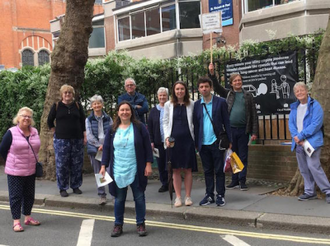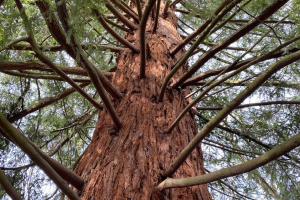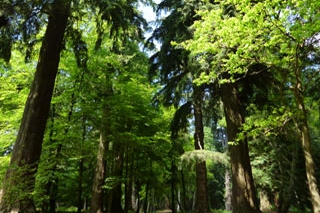Trees celebrated in walk around Westminster Cathedral

Tree walkers in Morpeth Terrace
How often do we notice the trees in places familiar to us?..
Why is it important to do so?..
And what does care of trees have to do with our faith?..
On Sunday 27 June, I joined a group finding out about trees in the vicinity of Westminster Cathedral. I've visited the area many times since childhood, but hardly noticed them before now.
This was an event as part of London Climate Week. The experience, organised by Westminster Justice and Peace, was special because it seemed to be the first time that valuing trees was firmly on the agenda of a diocesan body.
It seemed strange to be gathering outside the Cathedral under a banner, 'Tree Walk from Westminster Cathedral,' but it shouldn't have been. Care of Creation is an element of Catholic Social Teaching, all underlined by the 2015 Encyclical, Laudato Si'.
Colette Joyce, Westminster Justice & Peace Co-ordinator, led the two-hour walk. She reflected on the importance of trees within Christian tradition and invited contemplation of some of the many beautiful trees within easy walking distance of Westminster Cathedral.
As we strolled, we were encouraged to think about the nature and purpose of trees, especially their role in maintaining a stable climate that enables all life on Earth to exist and thrive. Trees bind soil, remove carbon dioxide from the air and release oxygen, as well as providing a home for many species of birds and insects. Along the way we considered, too, the significance we attach to trees - from the solemn prayer before the wood of the Cross to the celebratory decoration of Christmas trees.
When we met outside Westminster Cathedral's West Door we were immediately invited to admire the two mature London Plane trees in the piazza. Plane was widely planted as a street tree during the 18th and 19th centuries, being sturdy and suitable for city life for many reasons. It requires little root space and can survive in most soils and a wide range of temperatures. One of these two trees provided welcome shade for my son James who spent a number of hours standing with young people from dioceses around England and Wales waiting to see Pope Benedict during his visit in 2010. The Westminster youth contingent was under the Plane tree nearest the West Door, and he was very grateful.
We learnt that more than half of London's eight million trees are Planes and they provide the important service of removing pollution from the atmosphere. The mottled olive, brown and grey bark breaks away in large flakes to reveal new cream-coloured bark underneath, a process which cleanses the tree of pollution stored in the outer bark. Each year London's trees remove 2,241 tonnes of pollution which is a major contribution to public health.
When we moved off down Morpeth Terrace we passed rows of Plane trees and stopped at the end under a statue of St Francis of Assisi for a short reflection and prayer. Then there was Willow Place, named after Willow trees that were formerly common here. And Ginkgo in Rochester Road, a tree which survived the dinosaurs and the ice age, and, Colette told us, was the first tree to recover in Hiroshima after the city was destroyed by a nuclear bomb in August 1945. Then we walked around Vincent Square, a 13-acre green space lined with mature trees including London Plane. In Rutherford Street we admired the Silver Birches, whose white bark reflects heat and whose tolerance to pollution makes them a common sight in urban landscapes. Silver Birches also provide food and habitat to more than 300 insect species.
By gardens near the Cardinal Hume Centre we heard the tenth century, 'The Dream of the Rood' and heard how trees are mentioned in the Bible more than any living thing other than God and people. 56 Bible verses talk about trees.
We crossed Victoria Street and sat down in a grassy area for a short reflection on what trees mean to us. "Daily walks in the trees of Dulwich Wood got me though Covid" said one person. "This walk is a spiritual journey, about making a connection with trees," said another.
"They're the lungs of the world," and "we must learn to keep the mature trees, not just plant new ones," seemed to be common concerns about global deforestation and the HS2 project in particular in Britain. One member of the group lamented the disruption around Euston Station where she lives and has seen several public gardens destroyed and trees axed. We considered the quote from JRR Tolkien on our flier: 'Every tree has its enemy, few have an advocate. In all my works I take the part of trees against all their enemies.'
Of course, London used to be covered in forest. This is reflected in the fact that so many parts of London are named after trees and woods. There's the three Oaks (Burnt, Gospel and Honor), Nine Elms, Royal Oak Station, Wood Green, Forest Hill and Forest Gate.
Our final stop was St James' Park, a green gem of 57 acres and we stopped to admire a Black Mulberry, Weeping Beech and a Caucasian Wingnut! There are around 1,250 individual trees in St James's Park from around 35 species. The two islands in the lake, with their secluded woodlands and shrubberies, serve as nesting sites and refuges for birds. As we watched the ducks and geese waddling between the trees we thanked Colette profusely for this beautiful experience.
The walk was so successful that she has organised another one on 5 September! Several people have booked in already.


















